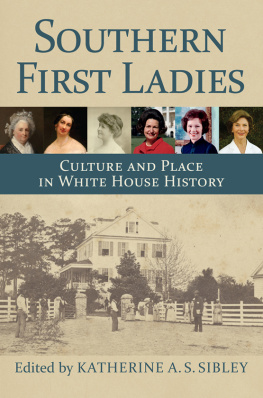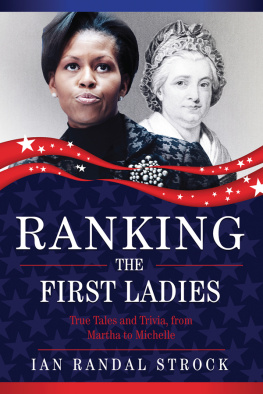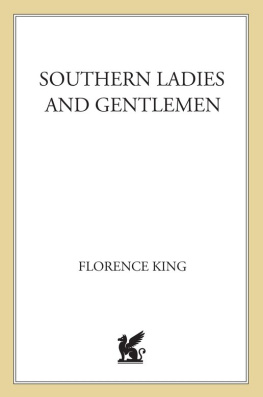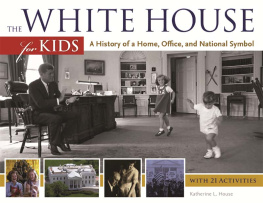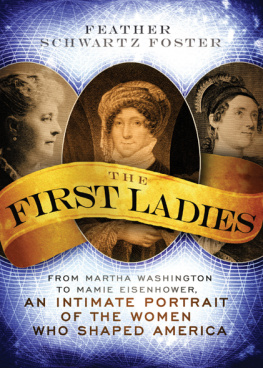Southern First Ladies
Southern First Ladies
Culture and Place in
White House History
Edited by Katherine A. S. Sibley
University Press of Kansas
2020 by the University Press of Kansas
All rights reserved
Published by the University Press of Kansas (Lawrence, Kansas 66045), which was organized by the Kansas Board of Regents and is operated and funded by Emporia State University, Fort Hays State University, Kansas State University, Pittsburg State University, the University of Kansas, and Wichita State University.
Library of Congress Cataloging-in-Publication Data
Names: Sibley, Katherine A. S. (Katherine Amelia Siobhan), 1961 editor.
Title: Southern First Ladies : culture and place in White House history / edited by Katherine A. S. Sibley.
Other titles: Culture and place in White House history
Description: [Lawrence] : University Press of Kansas], [2021] | Includes index.
Identifiers: LCCN 2020022376
ISBN 9780700630431 (cloth)
ISBN 9780700630448 (ebook)
Subjects: LCSH: Presidents spousesUnited StatesBiography. | WomenSouthern StatesBiography. | Presidents spousesUnited StatesHistory. | Presidents spousesPolitical activityUnited States. | Presidents spousesUnited StatesSocial life and customs. | White House (Washington, D.C.)Social aspects. | PresidentsFamily. Classification: LCC E176.2 .S68 2021 | DDC 973.09/9dc23
LC record available at https://lccn.loc.gov/2020022376.
British Library Cataloguing-in-Publication Data is available.
Printed in the United States of America
10 9 8 7 6 5 4 3 2 1
The paper used in the print publication is acid free and meets the minimum requirements of the American National Standard for Permanence of Paper for Printed Library Materials Z39.48-1992.
To Randall M. Miller
Contents
, Jeffrey A. Engel
Catherine Allgor and Katherine A. S. Sibley
Diana Bartelli Carlin
Merry Ellen Scofield
Mary Stockwell
Christopher J. Leahy and Sharon Williams Leahy
Teri Finneman
Sylvia D. Hoffert
Laura Mammina
Teri Finneman
John F. Marszalek
Louie P. Gallo
Nancy Beck Young
Lisa M. Burns
Valerie Palmer-Mehta
Nancy Kegan Smith
Kristin L. Ahlberg
Myra G. Gutin
Janette Kenner Muir
Anita B. McBride
Katherine A. S. Sibley
Foreword
There is a pattern to the story, and also a message. Dining together, or perhaps riding in a horse-drawn carriage, in a plush Pullman, or in a modern motorcade, the president of the United States turns with self-satisfaction to ask his first lady: Arent you glad you married me? If you were married to that (insert profession here), youd only be the wife of (same profession).
If I was married to him , she quickly retorts, he would have been president.
Humorous for sure, the vignette is not necessarily good history. I doubt, in fact, such a conversation ever took place, yet one can easily find it attributed to the Obamas, the Bushes (both generations), the Clintons, and why not the Eisenhowers and the Hardings, too? There seems a perpetual desire to cut down the great man just a little with the reminder that he did not make it alone.
Which happens to be true. Presidents do not scale such heights on their own, and nearly all found comfort, support, guidance, and a partner within their marriage. Long before the women in this book bore the title first lady, their savvy, political acumen, advocacy, and often warmth (sometimes in contrast to their husbands chillier dispositions) formed a critical part of the presidents rise. Those same attributes, as this volume shows, critically affected each mans presidency as well.
So, too, did they affect American culture writ large because first ladies are so much more than merely presidential partners. Hillary Rodham Clinton embodied a transformation of womens role in US society, but she was not the first first lady to leave her mark. One cannot tell the nations story of the 1840s without noting Sarah Polks political might, or the 1860s without employing Mary Todd Lincolns travails, which reflected the broader nations. Obviously, no retelling of the failed peace following the Great War is truly complete without reference to Edith Bolling Wilson; neither can we understand fully the US environmental movement without Lady Bird Johnsons role. Outside the United States, first ladies such as Laura Bush also left their stamp. Her ongoing initiatives include the Presidents Emergency Fund for AIDS Relief and the US-Afghan Womens Council, which promotes education for women and girls in Afghanistan.
The point is not that first ladiesand not so far from now, first gentlemen, tooinfluence their partners; it is that they are best understood as part of the broader tapestry of the countrys presidential past and present. And in this case, the peculiar and particular tapestry of the South, a region whose politics, identity, and social mores resound far beyond its borders. This volume in your hands is not the first to explore first ladies or the initial exploration of the land below the Mason-Dixon Line. But it is unique in doing both at once, reflecting the manner in which first ladies have both an influence and a history of their own tied to place and context, with implications both for White House traditions and the activism in which these women engaged. The Center for Presidential History could not be prouder of the part we played in bringing this group of extraordinary scholars together. Their work is our joy and your gain.
Jeffrey A. Engel
Director, Center for Presidential History
Southern Methodist University
March 10, 2020
Acknowledgments
This volume has been a collaboration, and I am so appreciative for the help of so many in making it possible. Without the warm welcome I received from Jeffrey A. Engel, director of the Center for Presidential History (CPH) at Southern Methodist University, to host our conference in 2018, this book likely would never have seen the light of dayand definitely would not have had such a joyful emergence. Quickly grasping the significance of place in White House history, Jeff invited me in 2017 to present a talk and then in 2018 to organize a conference at the CPH, Southern Belles, Washington Balls, and Dixies Reach: How Southern First Ladies Changed Americas Compass, where a number of our authors first presented our work on this topic. In addition to hosting and connecting me with contributors who have enriched this book, he invited C-SPAN to broadcast our gathering. As I write this I am reminded again of that special time, and I would especially like to thank Ronna Spitz, coordinator at the CPH, who so kindly made all the arrangements. I am also most grateful to Tom Zeiler, for years my dear colleague at the Historical Advisory Committee at the US State Departments Office of the Historian, who introduced me to Jeff and the CPH.
So many of my first lady scholar colleagues have made this such an interesting and deeply satisfying ride! I want to thank most enthusiastically for their inspiration and, often, their essential editing advice, the following wonderful people: Kristin Ahlberg, Catherine Allgor, Carl Anthony, Mary Brennan, Lisa Burns, Diana Carlin, Teri Finneman, Louie Gallo, Myra Gutin, Chris Leahy and Sharon Williams Leahy, John Marszalek, Anita McBride, Jody Natalle, Valerie Palmer-Mehta, Janette Muir, Melly Scofield, Nancy Smith, Molly Wertheimer, and Nancy Beck Young, all of whom have been on this first lady special with me for quite some time now. For assistance with the research in my own chapter, I would also like to thank Glenn Whaley and her staff at the Central Arkansas Library System and its Butler Center for Arkansas Studies, who so generously granted me the Jim Pledger Memorial Research Award for Use of Clinton-era Materials on Education in 2018. I gratefully extend my appreciation as well to the staff at the Lyndon Baines Johnson (LBJ) Library who welcomed me and helped me find such good resources, as did the archivists at Princetons Seeley Mudd Library and the George W. Bush Presidential Library. While this project was developing, Anita McBride, director of the First Ladies Initiative at American University, and Natalie Gonnella-Platts, director of the Womens Initiative at the George W. Bush Presidential Center, kindly invited me to participate in their events, including the First Ladies in Service panel discussion at the National Archives in 2016, the Engage: The Role of the First Lady presentation at the George W. Bush Presidential Center in 2018, and the White House Historical Associations Presidential Sites Summit in 2019, events where I had the opportunity to meet in person our three most recent first ladies. These opportunities have all given me fresh inspiration.


